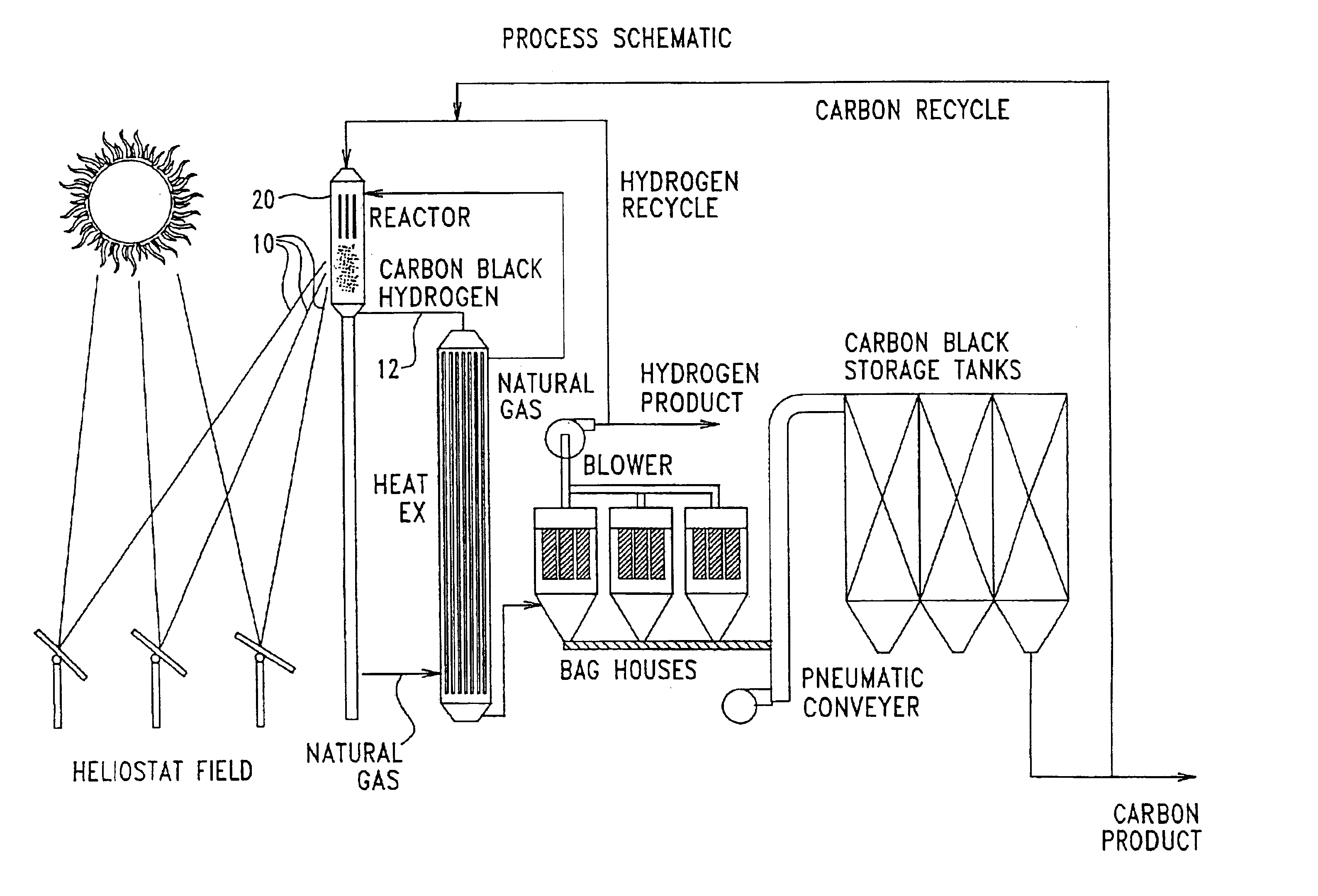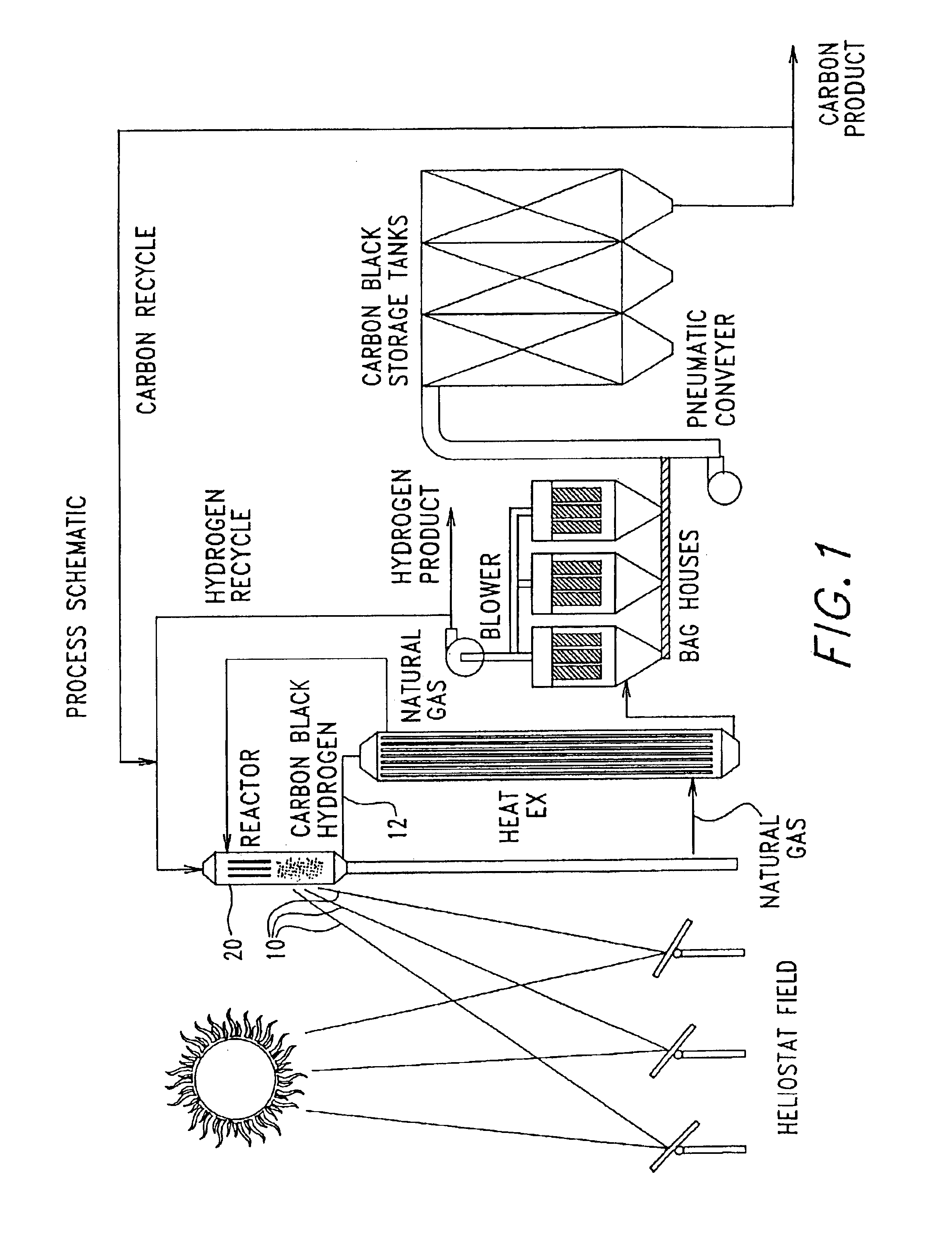Solar thermal aerosol flow reaction process
a technology of solar thermal aerosol and reaction process, which is applied in the direction of sulfur compounds, sulfur preparation/purification, lighting and heating apparatus, etc., can solve the problems of contaminated gas reserves, limited usable fossil fuel supply, and inability to economically develop for use in existing pipeline systems
- Summary
- Abstract
- Description
- Claims
- Application Information
AI Technical Summary
Benefits of technology
Problems solved by technology
Method used
Image
Examples
example 1
In accordance with the present invention, the NREL reactor apparatus developed for the synthesis of fullerenes was modified as shown in FIG. 3. A 25 mm quartz tube was positioned at the nominal focus of and normal to the optical axis of the HFSF with its axis “vertical,” and with the ends of the tube extending beyond the limits of the concentrated solar flux provided by the HFSF. A 15.2 cm long×6 mm outer diameter graphite tube 26 with an inner diameter of 3 mm was positioned inside the quartz reaction tube 20. Shawinigan™ acetylene carbon black particles 12 were dispersed at a nominal rate of 0.1 grams per minute in a 5 volume % methane-in-argon reactant process gas 14 using a spinning brush particle feeder 18. The mixture containing the gas and the carbon particles was injected into the graphite tube 26 from bottom to top. The reactant process gas 14 was fed at a rate of 0.2 standard liters per minute (SLM) into the graphite reaction tube 26. A fluid wall 22 was created by injecti...
example 2
The process parameters used in Example 1 were repeated with the exception that no carbon particles were fed in the process. The product gas was measured by the calibrated thermal conductivity detector to have a hydrogen content of 0.16% H2, corresponding to a reduced methane conversion of 18%. Carbon black produced according to reaction (1) was collected in a downstream filter and analyzed by transmission electron microscopy (TEM). The carbon black was amorphous and was comprised of carbon particles having a size in the range of 20 to 40 nanometers. This example indicated that the feeding of fine carbon black particles to the process (per Example 1) increases the conversion of the thermal dissociation of methane for low temperatures. This example also indicates that amorphous fine carbon black powder is produced in the process and provides an in-situ method of generating carbon black radiation absorbers in the reactor (without having to feed it).
examples 3 to 6 (
Varying Solar Flux)
The apparatus described in Example 1 was used. The reactant gas flowed at a rate of 0.2 SLM and had a composition of 10 mole % CH4 in argon. The annular “purge” argon flow rate was 1 SLM and no carbon particles were fed. The adjusted molar concentration of CH4 accounting for a combined reactant purge gas stream near the exit of the graphite reaction tube was 1.67%. The estimated flux of concentrated sunlight heating the graphite reaction tube target was varied as 1170 kW / m2, 1780 kW / m2, 2060 kW / m2, and 2350 kW / m2 for Examples 3, 4, 5, and 6, respectively. The corresponding temperatures in the reaction tube were 1550, 1730, 1820, and 1900° K., respectively. The residence time varied in the range of 0.019 to 0.015 seconds. The response of the hydrogen content in the flowing product gas stream resulting from the solar flux changes is shown in FIG. 4. The conversion of methane according to reaction (1) was calculated from the measured concentration of H2 and was 7%, 3...
PUM
| Property | Measurement | Unit |
|---|---|---|
| particle sizes | aaaaa | aaaaa |
| residence time | aaaaa | aaaaa |
| residence time | aaaaa | aaaaa |
Abstract
Description
Claims
Application Information
 Login to View More
Login to View More - R&D
- Intellectual Property
- Life Sciences
- Materials
- Tech Scout
- Unparalleled Data Quality
- Higher Quality Content
- 60% Fewer Hallucinations
Browse by: Latest US Patents, China's latest patents, Technical Efficacy Thesaurus, Application Domain, Technology Topic, Popular Technical Reports.
© 2025 PatSnap. All rights reserved.Legal|Privacy policy|Modern Slavery Act Transparency Statement|Sitemap|About US| Contact US: help@patsnap.com



